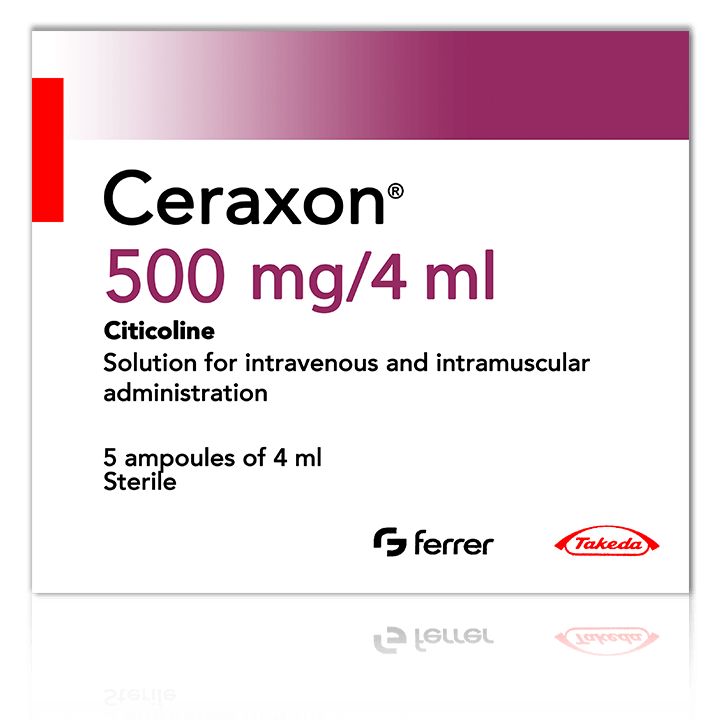Ceraxon® (Citicoline) Instruction
International Non-Proprietary Name (INN): citicoline
Dosage form: solution for intravenous and intramuscular injections
Structure
In a 4 ml ampoule:
Active ingredient: citicoline sodium 522.5 mg, equivalent to 500 mg of citicoline;
Excipients: hydrochloric acid 1М or sodium hydroxide 1М to рН 6.5–7.1, water for injections to 4 ml.
Description
Transparent colorless liquid.
Pharmacological classification: nootropic
ATC code: N06BX06
Pharmacological action: nootropic

Pharmacodynamics
Being a predecessor of the key ultrastructural components of the cell membrane (mainly phospholipids), citicoline has a wide spectrum of action – it helps to repair damaged cell membranes, inhibits the effect of phospholipases, prevents excessive formation of free radicals, and prevents cell death by affecting the mechanisms of apoptosis. In the acute period of a stroke, citicoline reduces the amount of damage to the brain tissue and improves cholinergic transmission. In the case of craniocerebral injury, it reduces the duration of post-traumatic coma and the severity of neurologic symptoms; besides, it helps to reduce the duration of the recovery period.
In chronic cerebral hypoxia, citicoline is effective in treating cognitive disorders such as memory impairment, lack of initiative, difficulties arising from daily activities and self-care. It increases the level of attention and consciousness and reduces the manifestation of amnesia.
Citicoline is effective in the treatment of sensitive and motor neurological disorders of degenerative and vascular etiology.
Pharmacokinetics
Absorption: Citicoline is well absorbed when ingested intravenously or intramuscularly.
Metabolism: The medicine is metabolized in the liver with the formation of choline and cytidine. The concentration of choline in the blood plasma is significantly increased after an intake.
Distribution: Citicoline is mainly distributed in the structures of the brain, with the rapid distribution of choline fractions into the structural phospholipids and cytidine fractions – into cytidine nucleotides and nucleic acids. Citicoline penetrates into the brain and is actively embedded in the cellular, cytoplasmic and mitochondrial membranes, forming part of the fraction of structural phospholipids.
Excretion: Only 15% of an administered dose is excreted from the body: less than 3% – by the kidneys and through the intestine and about 12% – with exhaled CO2.
There are two phases in the excretion of citicoline with urine: the first phase lasts for about 36 hours, during this phase the rate of excretion rapidly decreases; during the second phase the rate of excretion decreases much more slowly. The same is observed in exhaled CO2 – the excretion rate quickly decreases after about 15 hours and then starts to decrease much more slowly.
Intended uses
- acute period of an ischemic stroke (as part of the complex therapy);
- the recovery period after an ischemic and hemorrhagic strokes;
- craniocerebral injury, acute (as part of the complex therapy) and recovery periods;
- cognitive and behavioral disorders in degenerative and vascular diseases of the brain.
Contraindications
- hypersensitivity to any of the ingredients;
- expressed vagotonia (predominance of the tone of the parasympathetic part of the vegetative nervous system);
- rare hereditary diseases associated with intolerance to fructose;
- due to the lack of sufficient clinical data, the medicine is not recommended for children under 18 years old.
Dosage and administration
Ceraxon® is administered intravenously or intramuscularly.
The medicine is prescribed in the form of a slow intravenous injection (during 3–5 minutes depending on the dosage) or a drip infusion (40–60 drips per minute).
Intravenous administration is preferable. In the case of an intramuscular administration, a repeated injection in the same place should be avoided.
Acute period of an ischemic stroke and craniocerebral injury
1000 mg every 12 hours starting from the first day of diagnosing. The treatment lasts for at least 6 weeks. After 3–5 days of the treatment, (if the swallowing function is not impaired) the transfer to Ceraxon® for oral administration is possible.
The recovery period after ischemic and hemorrhagic strokes, the recovery period after a craniocerebral injury, cognitive and behavioral disorders in degenerative and cerebrovascular diseases of the brain
500–2000 mg per day (5–10 ml 1-2 times a day). Dosage and duration of treatment depend on the severity of the disease’s symptoms. It is possible to take per os forms of Ceraxon® medicine.
Elderly patients
When prescribing Ceraxon® to elderly patients the dose adjustment is not required.
One ampoule of the solution is for single-use. It must be used immediately after opening. The medicine is compatible with all types of intravenous isotonic and dextrose solutions.
Side effects
Rare: Allergic reactions (rash, skin itch, anaphylactic shock), headache, dizziness, heat, tremor, nausea, vomiting, diarrhea, hallucinations, swelling, dyspnea, insomnia, agitation, decreased appetite, numbness in paralyzed limbs, changes in hepatic enzymes activity. In some cases, Ceraxon® can stimulate the parasympathetic system, as well as produce a short-term change in blood pressure.
If any of the side effects listed in the instruction are aggravated, or if other side effects not listed in the instruction occur, consult a doctor.
Overdose
Given the low toxicity of the medicine, overdose cases are not described.
Interaction with other drugs
Citicoline increases the effects of levodopa. Do not prescribe in combination with medicines containing meclofenoxate.
Pregnancy and lactation
There is no sufficient data on the use of citicoline in pregnant women. Although no adverse effects have been identified in animal studies, Ceraxon® is prescribed during pregnancy only in cases when the expected benefit to the mother exceeds the potential risk to the fetus. When prescribing Ceraxon® during lactation, breastfeeding should be discontinued, as there is no data on the citicoline exertion with human milk.
Influence on the ability to drive vehicles and operate mechanisms
During the treatment, caution should be taken when performing potentially dangerous activities requiring special attention and quick reactions (driving vehicles, working with moving mechanisms, control engineer and operator work, etc.).
Terms of release from pharmacy
On prescription.
Storage conditions
Store at a temperature no higher than 30°C. Keep out of the reach of children.
Shelf life
3 years. Do not use beyond the expiration date printed on the package.
Manufacturer
Takeda Pharmaceutical / Ferrer Internacional, Spain. https://www.takeda.com/, https://www.ferrer.com/